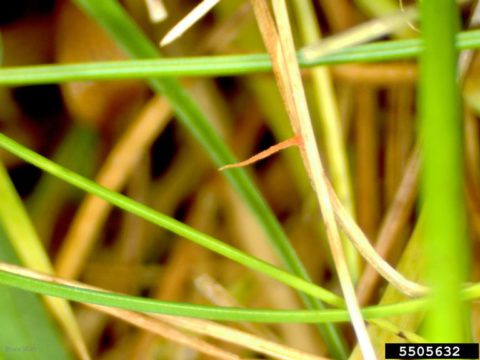
Red thread can infect lawns in spring. Photo: Bruce Watt, University of Maine, Bugwood.org.
Have you seen yellow, brown or dead-looking patches in your lawn this spring? It may be infected with red thread.
Our current wet weather pattern provides prime conditions for fungal diseases to sprout on grass and other plants. Overwatering and light, drizzly rains make diseases more difficult to control.
Red thread is a common disease in western Washington lawns. It begins with irregular yellow or darkened patches in the lawn from two inches to 24 inches wide. The leaves gradually become bleached, brown or scorched looking.
The disease moves from the leaf tip down the blade. As it advances, you can see small pink or red horn-shaped fungal threads extending from grass blades in bright light conditions (see photo). The disease spreads by rain, wind, mowers and other equipment.
The good news is that red thread doesn’t usually kill turf. It won’t look attractive, but the lawn often recovers as the weather warms and dries.
What should you do about red thread?
There is no substitute for proper lawn care. Diseases are more severe on turf that is thin and unhealthy. It is not effective to use fungicides to treat red thread in western Washington.
If you are a lawn care client, we will help keep your lawn healthy. This will reduce diseases and the lawn recover from disease infestations. If you are not a client, you should:
- Use balanced fertilizers to help the lawn stay healthy. Use an organic or slow-release fertilizer to feed the lawn slowly over time.
- Apply calcium as needed to reduce soil acidity.
- Aerate the lawn to keep plants healthy and help them uptake nutrients.
Proper watering helps to combat red thread
Use good watering techniques. If you water for short periods of time, the water doesn’t penetrate deeply enough into the lawn roots. It is better to water your lawn less frequently and leave the sprinkler on for a longer period. Your lawn needs one inch of water a week, from rain, irrigation or a combination.
If your lawn is currently infected with red thread, do not allow it to go under summer drought stress. Water the turf regularly in summer to maintain lawn health.
Proper mowing and mower care is important
Mow your lawn regularly. Do not allow it to grow long, especially when the weather is cool and wet. Lawns should be cut to 2-1/2 to 3 inches.
Keep mower blades sharp so they cut, rather than tear, the grass.
Do not mulch mow if there are diseases in your lawn. Mulch mowing is beneficial on healthy lawns. But if the lawn is infected with red thread, remove the clippings until the lawn is fully recovered. The fungus lives on affected grass blades.
Wash the underside of your mower between mowing cycles. Use a diluted solution of chlorine bleach or hydrogen peroxide and let it dry.
Red thread can be spread from lawn to lawn. If you have a lawn mowing service, ask them to clean the mowers between lawns.
Other steps you may need to take
If your lawn is on soggy soil, correct drainage so the turf will dry after it rains. Wet soil and standing water contribute to disease.
If your lawn is shaded, replace the lawn with ground covers that grow well in shade. Healthy turf requires sun.
Reference: Lawn Diseases on Home Landscapes in Western Washington, Seattle Public Utilities.
